Small Flies
ENTFACT-657: Small Flies | Download PDF
Simona Principato, Graduate Research Assistant
Zachary DeVries, Urban Entomologist
University of Kentucky College of Agriculture
Fast Facts
- Small flies are non-biting insects and do not transmit diseases, but they are important due to their association with the mechanical transfer of bacteria, especially on food.
- They can be a nuisance pest in homes, multifamily housing, commercial kitchens, and greenhouses during the warmer season.
- Adult flies are mobile, but larvae have limited movement and are usually found in rotten fruits, soil, shower drains or decaying organic matter
- Killing adult flies usually provides only temporary relief. Proper management requires removal of the larval breeding source and elimination of adults in the area.
Small flies (Order: Diptera) are common indoor pests that can grow significantly in homes becoming a nuisance during the warmer seasons, like spring and summer. Typically, they infest organic materials in kitchens but may also breed in soils of indoor plants or standing water in bathrooms. The most commonly encountered small flies include fruit flies, fungus gnats, drain flies and phorid flies.
FRUIT FLIES
Fruit flies, also commonly referred to as vinegar flies, banana flies, are tiny insects that tend to inhabit decomposing organic substances. They are frequently encountered in households, where they infest overripe fruits, leading to nuisance issues.
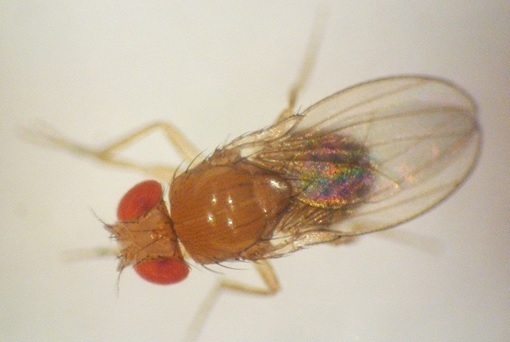
Biology
Fruit flies are generally outdoor insects that make their way into homes through open doors, windows, or other small openings, and establish where they find suitable substrates to feed and lay their eggs (Fig. 2). An individual female fruit fly has the capacity to lay over 500 eggs, meaning infestations can develop quickly. Eggs are deposited on fermenting food and other damp organic substances that the larvae feed on. Fruit flies start life as eggs, then hatch and progress through three larval phases before they pupate and ultimately emerge as adults. This entire cycle usually spans between 8 to 10 days under optimal conditions of 77°F which is suitable for their development. Adult fruit flies typically have a lifespan of around one month. Due to their short developmental time, lifespan and number of eggs that they can lay, major problems can occur quickly.
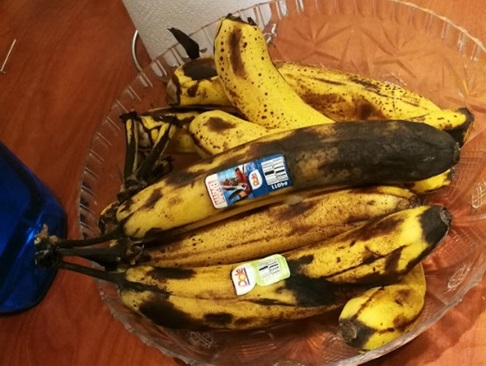
Identification
Adult fruit flies measure approximately 1/8 inches (3 mm) in length and are characterized by a brown-black body coloration and red or black eyes (Fig.1). These insects are frequently encountered in kitchens, often seen crawling on overripe fruit or around trash cans. In addition to fruit, they are also attracted fermented foods such as vinegar, beer, and various juices. Fruit flies have hovering capability (“helicopter flight”) and tend to fly quickly and with erratic movements.
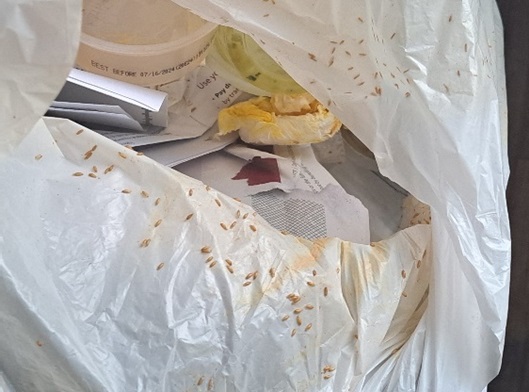
Issues
Although they pose minimal harm to humans, they can potentially contaminate food with bacteria. For this reason, they are considered unsanitary and can cause food and healthcare facilities to shut down for disinfestation and sanitation.
Management
Managing fruit flies relies on eliminating their breeding sites, usually by discarding infested items (e.g., overripe fruit). After removing the source, any remaining adult fruit flies can be eradicated mechanically (fly swatter or vacuum) or by using homemade traps baited with vinegar. These traps can be made by pouring vinegar into jar and add a drop of dish soap. Preventing fruit fly infestations involves eliminating potential breeding sites such as ripe fruits and vegetables, storing food properly as well as regularly emptying and cleaning trash bins to remove organic matter where females might lay their eggs (Fig. 3).
FUNGUS GNATS
Fungus gnats are small flies that thrive in moist soil or decomposing organic matter. They pose a significant challenge in greenhouses and nurseries due to the damage their larvae may cause to plant roots. Houseplants are also susceptible to infestations by these pests, leading to nuisance problems in households.
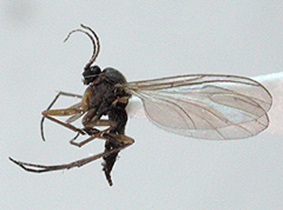
Biology
Fungus gnats typically live outdoors, but they can infest homes entering through doors and windows or infesting outdoor potted plants that are brought inside (Fig. 5). They become established when suitable substrates are present for their development. Female fungus gnats can deposit between 100 to 200 eggs either on moist soil surfaces or near plant stems. These eggs typically hatch within approximately four days. After hatching from eggs, they develop through four larval stages, pupate, and emerge as adults. Larvae are slender, worm-like and consume organic matter, fungi, as well as root hairs or delicate tissues, posing a threat to plant health. The duration of the entire life cycle varies based on temperature, usually taking around a month to complete. Adult fungus gnats are short-lived, having a lifespan of only 7 to 10 days.
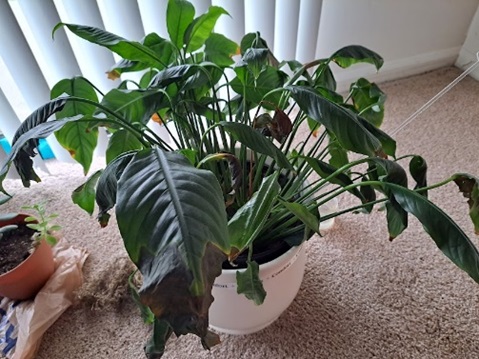
Identification
Adult fungus gnats resemble mosquitoes. They are typically about 1/8 inches (3-4 mm) in length with a slender black body, long antennas, transparent and/or gray wings, and long legs (Fig. 4). They are not strong fliers and prefer to remain near the growing medium, such as the soil of indoor potted plants where they are usually found flying when infesting homes. They are drawn to light and are commonly observed near windows.
Issues
They can enter homes through infested potted plants, leading to nuisance when large populations occur. They are usually reported flying around people’s faces and computer screens. Fungus gnats pose a significant challenge in greenhouses and nurseries as they harm plant roots; however, they do not bite humans.
Management
Once fungus gnats establish indoors it can be difficult to get rid of them. Control involves decreasing soil moisture and removing organic debris where the larvae thrive and feed. Most importantly, indoor potted plants should have adequate drainage. It may also be necessary to reduce the frequency of watering. By refraining from excessively overwatering plants, the proliferation of fungus gnats will be reduced. Using sterile potting mix is another preventive measure against fungus gnats. Moving plants outdoors or temporarily moving them out of the home for treatment can also help to reduce the population. When infestations are challenging, the application of insecticides, such as Bt for maggots, to the soil of potted plants may be needed. Adults can be managed with the use of sticky traps or by spraying potted plants with insecticides labelled for “house plants” (e.g. neem oil-based products). However, unless the breeding sites are eliminated, these methods only provide temporary solutions.
DRAIN FLIES
Drain flies (filter flies or moth flies) are small flies commonly found in and around homes and buildings, typically near locations with moisture and organic matter, such as drains. They are primarily considered a nuisance by people.
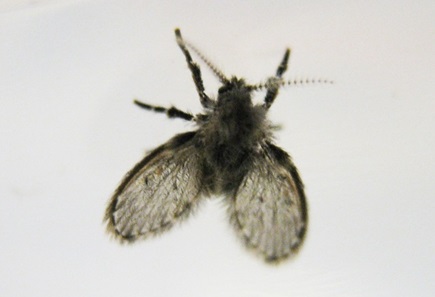
Biology
Drain flies are common outdoor insects and only occasionally invade homes. Female drain flies deposit clusters of 10 to 100 eggs in organic matter that obstructs sinks or shower drains, as well as in animal waste and sewage. These eggs have a rice-like appearance, ranging in color from cream to brown, and typically hatch within 48 hours at around 70 °F. All three larval stages of drain flies thrive in damp environments where they consume decaying organic matter, bacteria, mold, algae, and protozoa present in standing water (Fig. 7). The duration of the larval stages varies between 8 and 24 days depending on the temperature. After pupation, adult drain flies emerge within 20 to 48 hours and have a lifespan of 3 to 4 days, during which they feed on nectar and fluids from decaying sources.
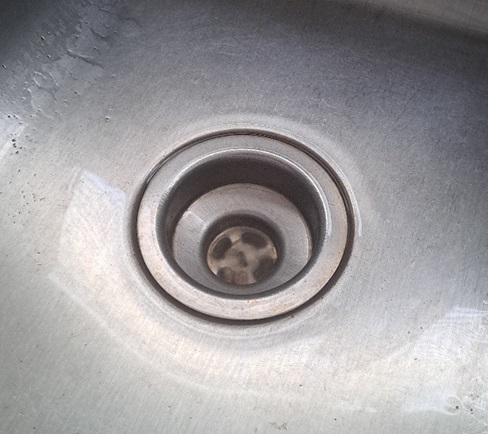
Identification
Adult drain flies look like miniature moths and measure approximately 1/16- 3/16 inch (2-4 mm) in length and are dark brown in color. Their bodies and wings are covered with fine hairs, and the wings, which are notably large and oval shaped, are positioned roof-like over the abdomen (Fig. 6). Drain flies are characterized by their weak flying ability, often moving in short hops. They commonly rest on walls near their breeding grounds, in bathrooms, kitchens, and near drains and sewage areas.
Issues
Drain flies are non-biting insects that do not transmit diseases, but they can lead to hygiene problems. Since they typically thrive in stagnant water found in sinks, toilets, or drains they could potentially spread bacteria. Inhaling their scale-like hairs could also lead to respiratory issues.
Management
Like other small fly problems, drain flies are best managed by eliminating their breeding sites. Drains can be effectively cleaned by using drain cleaning agents (e.g. enzyme cleaners, baking soda, vinegar) followed by hot water flushing. It is important to use a brush to remove the organic film within the drain to be able to eliminate developing sites. Additionally, sewage filters can be cleaned by flooding them for 24 hours to eradicate larvae, and this process may need to be repeated periodically since it doesn't affect the eggs. The use of pesticide is usually not necessary if the breeding source is located and removed. If pesticides are used for immediate control, it is important to carefully follow the label instructions.
PHORID FLIES
Phorid flies (also known as humpbacked, coffin, sewer, or scuttle flies) are small insects frequently found in homes around garbage bags, clogged drains or near decaying matter, creating nuisance for residents.
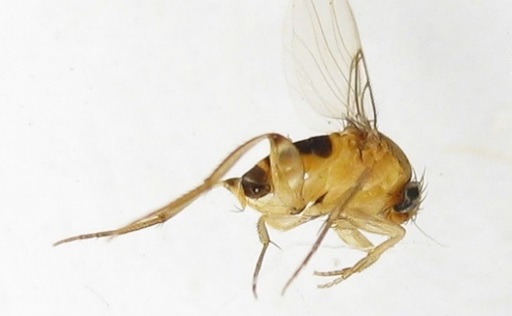
Biology
Phorid flies are typically outdoor insects. They are often parasitoids of other insects like fire ants and bumble bees. Some others are considered major pests in mushroom farms. They can enter homes through open doors or windows in autumn, during the peak of their reproductive season and can establish indoors by infesting decaying organic matter and even dead animals and animal waste (Fig. 8). Their life cycle includes the stage of egg, larvae, pupae and adult. Females can lay 100 eggs at a time, usually by moist organic matter. Under optimal conditions (~93 °F) it can take about 10 days for the entire development. Adults live about 1 to 2 months.
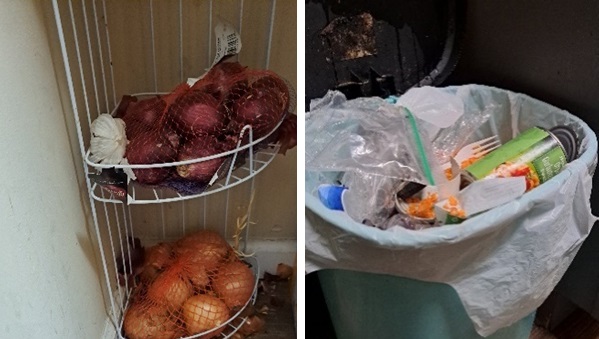
Identification
Phorid flies are about 1/8 inches (3 mm) long and resemble fruit flies, but they have a light brown/yellow humpback, hairs on the head and deeply marked veins on the front margin of their wings (Fig. 9). They can be easily identified by their tendency to run rapidly over surfaces when disturbed, rather than flying away (hints the name “scuttle flies”).
Issues
Phorid flies do not bite, but because they can breed on dirty substrates (e.g. leaking sewage, decaying material), they have the potential to transport pathogenic microorganisms to food and other surfaces, representing a public health threat.
Management
Due to their high reproductive potential, infestations can be difficult to control. It is essential to identify breeding sources to be able to eliminate infestations, although this can be difficult to spot since these flies can travel long distances and they can locate breeding sites buried well below ground (also why they got the name “coffin fly”). The most common locations to check in a home include garbage cans, standing water of leaking appliances (e.g. refrigerators, washing machines) and drain openings. The use of sticky traps can help to identify the origin of the infestation by seeing where the most flies are trapped. Light traps, sanitation and insecticides can help to reduce the populations but will not solve the infestation if the breeding site is not located and eliminated.
References
Fair, G.M., 1934. The trickling filter fly (Psychoda alternata), its habits and control. Sewage Works Journal, pp.966-981.
Ali, A., Kok-Yokomi, M.L. and Alexander, J.B., 1991. Vertical distribution of Psychoda alternata (Diptera: Psychodidae) in soil receiving wastewater utilized for turf cultivation. Journal of the American Mosquito Control Association, 7(2), pp.287-289.
Boumans, L., Zimmer, J.Y. and Verheggen, F., 2009. First record of the 'bathroom mothmidge' Clogmia albipunctata, a conspicuous element of the Belgian fauna that went unnoticed (Diptera: Psychodidae). Phegea, 37(4).
Va, D.P., Sa, A.A. and Paul, S.F., 2009. Wonder animal model for genetic studies-Drosophila melanogaster–its life cycle and breeding methods–a review. Sri Ramachandra Journal of Medicine, 2(2), pp.33-38.
Cloyd, R.A., 2008. Management of fungus gnats (Bradysia spp.) in greenhouses and nurseries. Floriculture and Ornamental Biotechnology, 2(2), pp.84-89.
Harris, M.A., Gardner, W.A. and Oetting, R.D., 1996. A Review of the Scientific Literature on Fungus Gnats (Diptera: Sciaridae) in the Genus Bradysia 2. Journal of Entomological Science, 31(3), pp.252-276.
Mullen, G.R. and Durden, L.A. eds., 2009. Medical and veterinary entomology. Academic press.
Koehler, P.G. and Short, D.E., 1995. Pests in and around the Florida home. Cooperative Extension Service, University of Florida, Institute of Food and Agricultural Sciences.
Disney, H., 2012. Scuttle flies: the Phoridae. Springer Science & Business Media.
04/25 (Issued)
CAUTION! Pesticide recommendations in this publication are registered for use in Kentucky, USA ONLY! The use of some products may not be legal in your state or country. Please check with your local county agent or regulatory official before using any pesticide mentioned in this publication.
Of course, ALWAYS READ AND FOLLOW LABEL DIRECTIONS FOR SAFE USE OF ANY PESTICIDE!
Images: Simona Principato,University of Kentucky Entomology unless otherwise indicated
